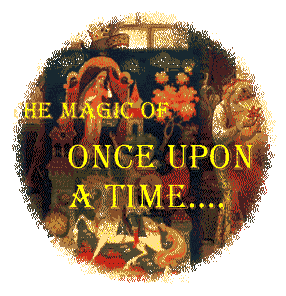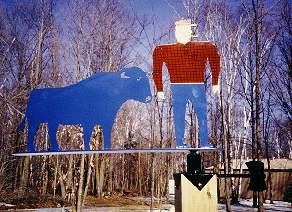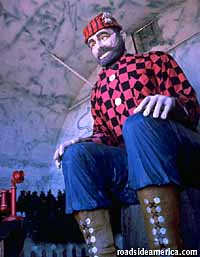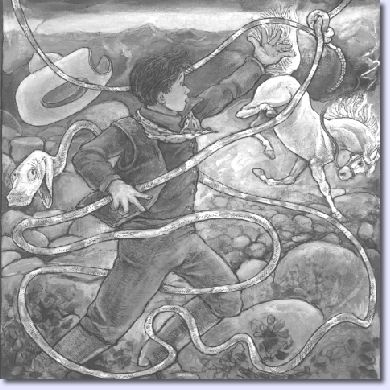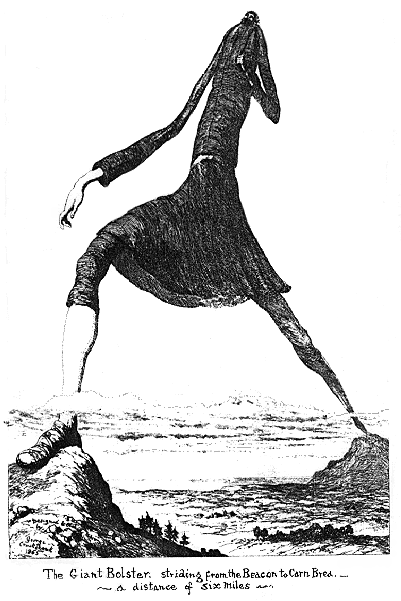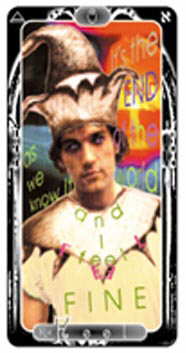|
Narrative Logo - Click for Main Menu Lecture V: Tale Types and Motifs
F. Marvels
Caption: Paul Bunyan and his Blue Ox, Babe - Metal Sign The Marvels section of the Tale Types illustrates the way in which the Motifs and Tale Types overlap, weave, and merge. Many fairy tales fall into the Marvels category because miraculous things happen in them. Tall Tales are often found in the Marvels category of types. American folklore is surprisingly full of this kind of tale, perhaps because there has, traditionally, been a large frontier out there in which anything could happen. Adventures such as those of Pecos Bill, Paul Bunyan and his Blue Ox, Babe, Johnny Appleseed - not to mention John Henry - figure prominently in the traditional American legendstock.
Graphic for American folklore tour I usually start my preparation for each of the lectures by looking through my own folklore book collection, then going to the WWW to see what shows up. Strangely enough, it is far easier to find European, Asian, and even Australian folk material than it is to find American folk lore. The thing that is out there is AmericANA - that is, the dinosaur gift shops, the hot-dog stands that look like a hot dog. Such curiosities are surely American, and are surely Marvels. But I had somehow hoped for a whole page on Paul Bunyan. So I searched again!
The giant plaster dinosaur I found out that Davy Crockett might not have died at the Alamo. Oh dear! I found this at the site of the Alamo Almost all schoolchildren are taught the story of the Alamo, where 200 volunteer troops died in hand-to-hand combat against over 4,000 Mexican troops under General Santa Anna after a siege lasting 13 days. Davy Crockett, we are told, fought to the death, swinging his rifle ("Betsy") like a baseball bat, in fending off the attackers until he finally fell. That has always been the accepted (with a few exceptions) version of how the battle was fought at the Alamo, and how Crockett died. But last Wednesday, a diary was sold at auction (for $350,000) that tells a different story; that Davy Crockett did not go down swinging at the Alamo. The de la Pena Diary The memoirs of Lt. Col. Jose Enrique de la Pena (With Santa Anna in Texas: A Personal Narrative) claim that Crockett and six or seven others, were captured at the Alamo and brought before General Santa Anna. When the General was told of Crockett's popularity in the United States, Santa Anna reportedly ordered them killed, and they were repeatedly stabbed with swords until dead. The de la Pena diary claims to be an eyewitness to this, and allegedly his anger at this incident, his criticism of Santa Anna's leadership (and Santa Anna's treatment of his troops during the Texas campaign that failed) ended up with de la Pena going to jail, and dying there in 1842. Icons, History and Firm Beliefs Some Alamo experts dispute the diary (although the paper it was written on was authenticated, as opposed to a recently-created hoax), and yet it still fetched $350,000 at auction. The fierceness of the denials can be equaled only by the denials of many Mexicans of what we here are taught of what went on at the Alamo. Would someone claim to have been Crockett when brought before Santa Anna in thoughts of being spared? The de la Pena account of the whole battle fits with some eyewitnesses, but the death of Crockett has numerous versions. But again, the point of this column is to point out of the fervent opinion's where heroes are concerned.
Caption: Large statue of Paul Bunyan This is from Roadside America Paul Bunyan gets trees a lot of free publicity. But he is also famous for cutting trees down in big numbers. Mythical, legendary, ugly numbers. Ecologist nightmare numbers. But there are few folk tales told about the adventures of a tree, or an ecologist, for that matter. Paul Bunyan is everywhere, and is much beloved. His birthplace in Bangor, ME is marked by a statue, but where you really fall all over Bunyan monuments are in the northern forests of Minnesota, Wisconsin, and Michigan. Minnesota offers big statues in Brainerd and Bemidji, which are also home to his axe, his phone, his pet dog, his pet squirrel, his toothpaste, razor and Zippo lighter. In Akeley, a twenty-five foot Bunyan bends down with hand outstretched, so that couples can sit in his palm for photos. Bunyan's girlfriend is in Hackensack, his anchor is in Ortonville, his rifle is in Black Duck, and he is buried (he died in 1899) in Kelliher. His epitaph: "Here lies Paul, And That's All."
Pecos Bill
Caption: Pecos Bill catching the wind an entertaining web-graphic version of Pecos Bill for the child in all of us.
Back to the drawing board. It seems that the traditional
American marvelous heroes often persist in Ballad rather than writing, as would fit a
culture that was still evolving an oral tradition, and whose pioneers did not always have
access to books.
Caption: The Giant Bolster striding across mountains from the Cornish Folktales Pages Other Marvels show up in the process of developing other, more primary motifs. "Boots and His Brothers" from Clarkson and Cross' World Folktales is a perfect example. In this story, we have Boots, who is the male equivalent of Cinderella in many tales (the youngest son, looked down upon) and corresponds to the "Jack" of American tales, the Pedro of Hispanic lore, or the Espen Askefjis of Norweigan stories. He is also associated with Pinkel of Sweden, the Dummling of Germany.
Caption: The Jester An example of Tale Type 577, the King's Tasks, this story (related in class), has several principal Motifs: D950.2--Magic Oak Tree D1581--Task Performed by use of Magic Object D1601.14--Self-chopping ax F715.1.1--River issues from magic nut H335--Task Assigned Suitor L10--Victorious youngest son T68--Princess offered as prize.
Wunderkammers
Caption: Electronic dogs and rabbits from the past The actual Marvels we love to see, however, often concern real things, like the marvels of the Magic Cabinets of the Victorian era. More about that next.
Caption: The Cabinet of Wonders The subject of Marvels actually illustrates an interesting rupture between the Church, which had always tried to suppress the lore of paganism, and emerging sciences in the 16th Century. This passage is from "Science and the Secrets of Nature"
by William Eamon The expanding Renaissance interest in
magic has been amply documented. However, modern scholarship has tended to treat natural
magic as a strictly intellectual problem, while ignoring its political and social
dimensions. Nor have historians looked seriously at the relationship of natural magic to
popular values and attitudes. Yet natural magic was an ideology as much as it was a
natural philosophy. Its rise to prominence in the sixteenth century and the campaign waged
by the Church against it cannot be understood in isolation from the momentous
Counter-Reformation debate over the future of Catholicism. Indeed, the controversy over
natural magic was essentially a political and religious dispute. At issue were doctrinal
uniformity and the Church's jurisdiction over supernatural forces. As John Bossy has
pointed out, the aim of the Tridentine reform was to enforce a code of uniform parochial
practice. Among the various measures it took to enforce parochial uniformity, the
Tridentine Church was particularly vigorous in its attempt to eradicate the "errors
and superstitions" of popular religion. Besides teetering dangerously close to
demonic magic, natural magic was anathema to the Church because it smacked of pagan
superstition. In this way, Marvels stories tend to have an uneasy relationship with conventional and traditional beliefs in European culture.
Caption: Museum installation of Wonders From the Harvard Magazine review of Wonders
and the Order of Nature, 1150-1750 (Zone Books, 1998),
|
